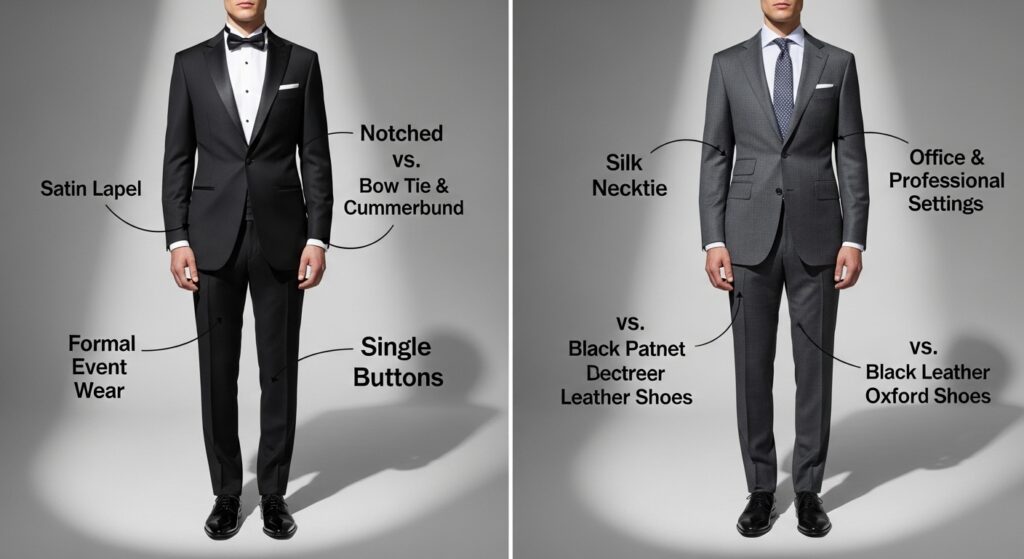When it comes to formal menswear, many people find themselves confused about the difference between a dinner suit vs business suit. While both are tailored outfits designed for sophistication, their purpose, style, and usage are very different. A dinner suit is often associated with black-tie events and evening elegance, while a business suit is tailored for professional settings like offices, conferences, and meetings.
Understanding the distinctions not only helps you dress appropriately but also ensures you make the right impression in any setting.
Defining the Dinner Suit
A dinner suit, commonly referred to as a tuxedo in the United States, is a formal evening outfit designed for special occasions.
Key Features of a Dinner Suit
-
Fabric: Usually crafted from fine wool or barathea.
-
Color: Traditionally black or midnight blue.
-
Lapels: Satin or grosgrain silk lapels for a luxurious finish.
-
Shirt: Paired with a crisp white dress shirt, often pleated.
-
Accessories: Typically worn with a bow tie, cummerbund, or waistcoat.
-
Shoes: Patent leather shoes or highly polished oxfords.
When to Wear a Dinner Suit
-
Black-tie events
-
Weddings and galas
-
Award ceremonies
-
Opera or theater premieres
A dinner suit emphasizes elegance and formality, marking it as the outfit of choice for evening occasions.
Defining the Business Suit
A business suit is a versatile wardrobe essential for professional and semi-formal settings.
Key Features of a Business Suit
-
Fabric: Lightweight wool, cotton blends, or polyester.
-
Color: Range of colors, often navy, grey, charcoal, or pinstripes.
-
Lapels: Standard notched lapels with minimal shine.
-
Shirt: Paired with collared shirts in solid or subtle patterns.
-
Accessories: Regular neckties, belts, and pocket squares.
-
Shoes: Leather lace-ups or loafers.
When to Wear a Business Suit
-
Job interviews
-
Office settings
-
Conferences and business meetings
-
Semi-formal social gatherings
The business suit offers flexibility, combining professionalism with comfort for daily wear.
Dinner Suit vs Business Suit: Side-by-Side Comparison
To clearly highlight the differences, here’s a breakdown:
| Feature | Dinner Suit | Business Suit |
|---|---|---|
| Occasion | Black-tie, evening events | Professional, daily use |
| Fabric | Luxurious wool, satin details | Versatile fabrics, lightweight wool |
| Lapels | Satin or grosgrain | Notched or peaked, plain fabric |
| Shirt | White formal dress shirt | Dress shirts in various colors |
| Tie | Bow tie | Standard necktie |
| Shoes | Patent leather | Leather lace-ups |
| Color | Black, midnight blue | Navy, grey, charcoal, pinstripes |
This comparison shows how the formality and styling of each suit suit different purposes.
Why the Difference Matters
Wearing the wrong suit to an event can leave a lasting impression—for better or worse. For example:
-
Wearing a business suit to a black-tie wedding might look underdressed.
-
Wearing a dinner suit to a daytime meeting can feel overly formal and out of place.
Understanding the dinner suit vs business suit distinction helps you choose attire that aligns with the occasion, setting, and expectations.
Benefits of Choosing the Right Suit
-
Confidence: The right suit boosts self-esteem in both social and professional settings.
-
Professionalism: In business, the correct attire establishes credibility.
-
Elegance: At formal events, a dinner suit ensures you look polished and sophisticated.
-
Versatility: A well-tailored business suit can be worn in multiple contexts.
Challenges in Choosing Between Dinner and Business Suits
Even with guidelines, many face challenges when deciding which suit to wear:
-
Cultural Differences: Some countries use “dinner suit” differently than others.
-
Fashion Trends: Modern interpretations sometimes blur the lines.
-
Budget Constraints: High-quality dinner suits can be costly.
-
Occasion Confusion: Semi-formal events often leave people unsure of the dress code.
Practical Scenarios: Choosing Correctly
-
Wedding Guest: If the invitation specifies “black tie,” go for a dinner suit.
-
Corporate Interview: A navy or charcoal business suit is the safe option.
-
Gala Event: A dinner suit ensures you meet formal expectations.
-
Client Presentation: A business suit shows professionalism without being overly formal.
Tips for Styling Each Suit
Styling a Dinner Suit
-
Stick to classic colors—black or midnight blue.
-
Pair with a white shirt and black bow tie.
-
Use minimal accessories for elegance.
Styling a Business Suit
-
Choose versatile colors like navy or grey.
-
Experiment with patterned ties or pocket squares.
-
Match shoes and belts for a polished look.
Looking Ahead: Modern Trends in Formalwear
The boundaries between dinner suits and business suits are slowly evolving. Today’s fashion landscape introduces:
-
Slim-Fit Cuts: Modern tailoring emphasizes a sleek, fitted look.
-
Color Experimentation: Business suits in light greys, checks, or subtle patterns are trending.
-
Fusion Styling: Some men wear dinner jackets with business trousers for a semi-formal blend.
-
Sustainable Fabrics: Eco-friendly materials are becoming popular in both dinner and business suits.
As workplaces become more casual and formal events more creative, understanding the classic dinner suit vs business suit distinction remains important while embracing evolving styles.
Conclusion
When comparing a dinner suit vs business suit, the key difference lies in their purpose: one is for elegant evening occasions, the other for professional and daily formal use. Knowing when and how to wear each ensures you always look the part, whether stepping into a boardroom or attending a gala.
Investing in both types can round out your wardrobe, giving you the confidence and versatility to adapt to any setting.





